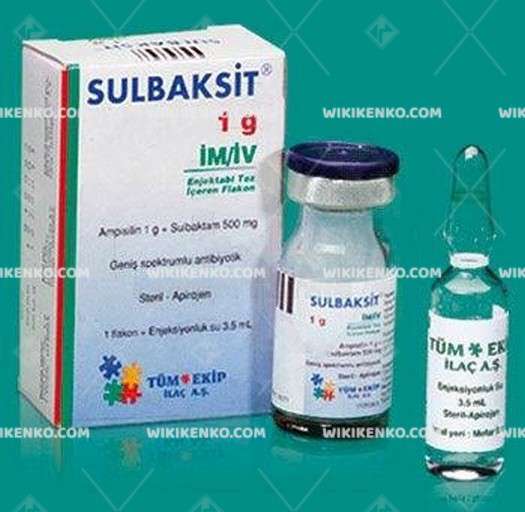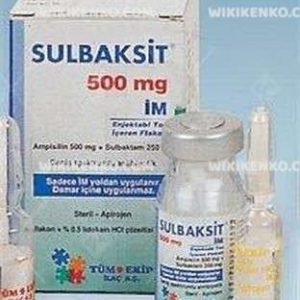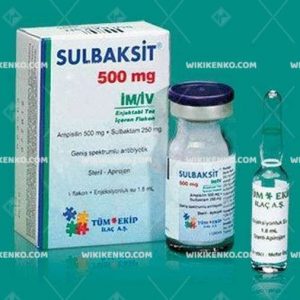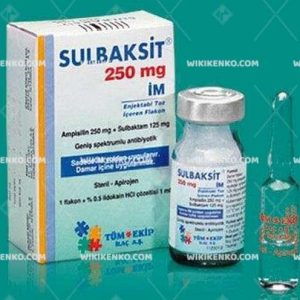Sulbaksit Im/Iv Injection Vial 1000 Mg/500Mg
In the realm of antibiotics, Sulbaksit shines as a formidable player. Comprising a dynamic duo of ampicillin and sulbactam, it belongs to the penicillin antibiotic group, adept at combatting even penicillin-resistant bacteria. In this comprehensive guide, we delve into the intricacies of Sulbaksit, from its composition to applications and availability.
| Dosage form | |
|---|---|
| Pack size | |
| Potency | 1000 Mg/500Mg |
| Manufacturer | |
| Origin | |
| Generic Name (Ingredient) | Each Vial Contains: Ampicillin Sodium Equivalent To 1 G Ampicillin And Sulbactam Sodium Equivalent To 500 Mg Sulbactam. Each Solvent Ampoule Contains 3.5 Ml Of Water For Injection. |
Assuming your emergency circumstances for this product, visit Urgent Quotation page. Besides, for any pharmaceutical questions, please ask us in the comments section.
Description
Ingredients
At its core, Sulbaksit combines two potent active ingredients: ampicillin and sulbactam. This amalgamation proves particularly effective in addressing infections caused by a spectrum of microorganisms. Its innovative approach lies in sulbactam’s ability to enhance ampicillin’s effectiveness, even against bacteria that have developed resistance to traditional penicillin antibiotics.
Indications
Sulbaksit emerges as a versatile pharmaceutical warrior, indicated for a multitude of infections caused by susceptible microorganisms. These encompass a wide range of conditions, including sinusitis, otitis media, epiglottitis, pneumonia, urinary tract infections, pyelonephritis, peritonitis, cholecystitis, endometritis, pelvic cellulitis, bacterial septicemia, and skin, soft tissue, bone, and joint infections. Furthermore, it demonstrates efficacy against gonococcal infections.
The comprehensive scope of its applications showcases Sulbaksit‘s prowess in the realm of antimicrobial therapy.
Sulbaksit Administration
The versatility of Sulbaksit is further underscored by its diverse administration options. It can be delivered intramuscularly or intravenously, providing flexibility in tailoring treatment to the patient’s needs. Each vial of Sulbaksit contains a potent blend of 1000 mg of ampicillin (as ampicillin sodium) and 500 mg of sulbactam (as sulbactam sodium). The accompanying solvent comprises 3.5 ml of sterile water for injection, ensuring a seamless and effective delivery system.
Identifying Contraindications
While Sulbaksit stands as a potent ally against bacterial infections, there are vital contraindications to consider. It should not be used by individuals with hypersensitivity to ampicillin and/or sulbactam or those who have experienced allergic reactions to any penicillin in the past. Additionally, caution must be exercised, as it is contraindicated during pregnancy or breastfeeding. Patient safety is paramount, and adherence to these contraindications is essential to ensure the medication’s efficacy and prevent adverse reactions.
Exploring Common Uses
Ampicillin and sulbactam, the dynamic duo within Sulbaksit, find common use in treating an array of bacterial infections. This combination proves effective against infections of the skin, female reproductive organs, and the abdominal region.
It is also a trusted choice for addressing a multitude of bacterial infections, including but not limited to tonsillitis, sinusitis, otitis media, respiratory tract infections, urinary tract infections, boils, abscesses, cellulitis, wound infections, bone infections, and oral cavity infections. The versatility of this combination cements its position as a go-to choice for many healthcare providers.
The Generic Version
For those seeking alternatives, a generic version of Sulbaksit is readily available under the name Sulbactam. This offers a cost-effective option while maintaining the therapeutic benefits of the original medication. To delve deeper into the specifics of the generic version, including its uses, indications, side effects, and dosage, individuals can explore the comprehensive information available on the website ndrugs.com.
Conclusion
Sulbaksit stands as a testament to the ever-advancing field of antibiotic therapy. Its unique combination of ampicillin and sulbactam unlocks a potent defense against a wide array of bacterial infections.
However, the importance of adhering to contraindications cannot be overstated, ensuring both patient safety and medication effectiveness. Sulbaksit‘s versatility and the availability of a generic counterpart offer healthcare professionals valuable tools in the ongoing battle against microbial adversaries. As always, this information serves as a valuable reference but is not a substitute for medical advice. Patients are encouraged to engage in discussions with their healthcare providers to determine the best course of treatment for their specific needs
Use the form below to report an error
Please answer the questions as thoroughly and accurately as possible. Your answers will help us better understand what kind of mistakes happen, why and where they happen, and in the end the purpose is to build a better archive to guide researchers and professionals around the world.
The information on this page is not intended to be a substitute for professional medical advice, diagnosis, or treatment. always seek the advice for your physician or another qualified health provider with any questions you may have regarding a medical condition. Always remember to
- Ask your own doctor for medical advice.
- Names, brands, and dosage may differ between countries.
- When not feeling well, or experiencing side effects always contact your own doctor.
Cyberchondria
The truth is that when we’re sick, or worried about getting sick, the internet won’t help.
According to Wikipedia, cyberchondria is a mental disorder consisting in the desire to independently make a diagnosis based on the symptoms of diseases described on Internet sites.
Why you can't look for symptoms on the Internet
If diagnoses could be made simply from a textbook or an article on a website, we would all be doctors and treat ourselves. Nothing can replace the experience and knowledge of specially trained people. As in any field, in medicine there are unscrupulous specialists, differences of opinion, inaccurate diagnoses and incorrect test results.







Reviews
There are no reviews yet.